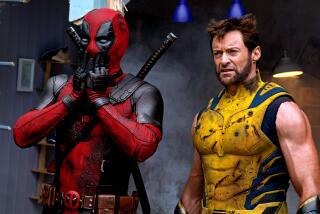A Subgenre Resurfaces : Hollywood has been boarding submarines since movie-making began--but never with the technology of ‘Crimson Tide.’
Fathom this: Howard Hughes, who by all accounts didn’t need much help going off the deep end him self, insisted that his aides screen his favorite movie 24 hours a day while he was sequestered in his Las Vegas penthouse suite. The movie? “Ice Station Zebra,” a 1968 action yarn starring Rock Hudson as a heroic submarine commander.
Such is the sometimes intense appeal of submarine films, whose dramatic notion of sweaty sailors coping with unseen enemies and life in an enclosed space has proved popular among stars, filmmakers and fans alike since Hollywood’s earliest days.
In addition to Hudson, male stars such as Cary Grant, Clark Gable, Humphrey Bogart, Charlton Heston, Kirk Douglas, Sean Connery and Ronald Reagan have been drawn to this genre--no rival to Westerns or musicals in sheer numbers but a hardy perennial now numbering more than 100 films.
The newest entry is “Crimson Tide,” which arrives in theaters Friday, starring Gene Hackman and Denzel Washington as commanding officers in a gritty underwater fight over control of a nuclear-armed U.S. sub.
(And dead ahead, in pre-production at 20th Century Fox, is “Down Periscope,” a contemporary comedy starring Kelsey Grammer as a career naval officer who is put in charge of a rickety World War II sub and a crew of rejects.)
Sydney Chaplin, Charlie’s brother, directed “Submarine Pirate” in 1915. The next entry in the genre, Frank Capra’s “Submarine,” didn’t come along until 1928, says Lawrence Suid, a military historian.
Films like “Submarine Patrol” (1938), “Submarine Raider” (1942) and “Submarine Command” (1951) extolled the virtues of the Navy while serving as rousing American propaganda for World War II and the Korean War. Clark Gable and Burt Lancaster squared off in “Run Silent, Run Deep” (1958), and Cary Grant served up both dramatic (1943’s “Destination Tokyo”) and comedic (1959’s “Operation Petticoat”) performances while doing sub service in Hollywood. But while the wars have come and gone, submarine movies continue to be made.
“There’s something very intense about them, because you have the characters closeted into an arena where something has to happen. It’s a very interesting way to set a dramatic piece,” Hackman says.
“Life in such a cramped tube with so many people makes for an extremely volatile situation,” adds Wolfgang Petersen, who directed the 1981 film “Das Boot,” regarded by many as the best submarine movie. “A submarine is like a shark. You can’t see it. It can go under water and attack you with its torpedoes and you’re history. Dead! Gone! It is the sheer invisibility of it which is not only mysterious, it’s scary. By living this existence, these men display the ultimate heroism, and audiences live vicariously through them.”
Earlier sub films held a practical attraction for filmmakers.
“They’re cheap. In the old days, the Navy would give you a submarine cruising on the surface, and the studio would build two or three sets on a soundstage and there was usually a small cast,” says Suid, author of “Sailing on the Silver Screen,” due out this winter from Naval Institute Press. “The dramatic appeal is what the audiences see. The cheapness is what the filmmakers see.”
But those days are long gone. Director Tony Scott, producers Jerry Bruckheimer and Don Simpson and their creative team spent millions of dollars on state-of-the-art technology to give “Crimson Tide” a grimly realistic feel.
The producers hired special-effects veteran Al DiSarro, who oversaw the effects on 1990’s “The Hunt for Red October,” to take charge of the demanding technical aspects of “Crimson Tide.” Bringing off the rocky underwater moves of the submarine’s interior was his biggest challenge. A massive 45-by-60-foot hydraulic gimbal--a platform device upon which the sets are placed and actually move 17 to 25 feet off the ground--was built on a Culver City soundstage for about $1.5 million.
A smaller gimbal was used to good effect but less extensively on “The Hunt for Red October”; the “Crimson Tide” gimbal is said to be the biggest in Hollywood history. “Most of these (gimbals) in the past have been built out of the boneyard at a back of a studio. They’ve been nothing but a problem,” DiSarro admits. “So when ‘Hunt’ came along, we designed and engineered a gimbal from scratch.”
The “Crimson” gimbal includes a variable-speed control and a new shuttering mechanism that can simulate a submarine being hit by a torpedo. Once completed, director Scott threw sometimes up to 50 tons of cast, crew and sets onto the platform, careening from one side to the other as many as 30 degrees. “Tony asks for a lot,” says DiSarro, who also worked with the director on “The Last Boy Scout” and “True Romance.” “He is a very demanding director as far as getting the look that he has in his head onto the screen.”
“Historically, the gimbal is a nightmare because things are always going wrong and you’re always being shut down so it costs you time and money,” Scott explains. “But we were never shut down for even a day. I used it a lot because . . . it rocks and rolls and dips and dives just like the real thing.”
Submarine movies have certainly come a long way since 1958’s “Run Silent, Run Deep,” when Gable and Lancaster stood on a soundstage while shoddy backdrops stood in for submarine atmosphere. Twenty-three years later, Petersen achieved a more realistic effect in “Das Boot,” spending a painstaking three months on the exterior weather shots, utilizing electronically controlled puppets and a miniature submarine.
“Wolfgang achieved a powerful sense of claustrophobia by using wide-angle lenses and going in close on people,” Scott says. “My idea (for “Crimson Tide”) was to go with a long lens from the actors, which made everything close in on them, where Wolfgang did the total opposite. But both worked.”
Early on, before “Crimson Tide” was greenlighted by the studio, many of the film’s key players, including the director, producers and screenwriter, were allowed by the Navy to spend six hours on the Florida, a ballistic missile submarine. “It’s the biggest submarine that the United States has,” says “Crimson Tide” set designer Mickey Michaels. “These are all very big classified toys.”
The submarine is the same class as the Alabama, upon which the fictional story of “Crimson Tide” takes place. “We went under the ocean for six hours, and I am here to tell you that it’s not my idea of a good time,” says producer Don Simpson. “I am not a major fan of enclosed spaces anyway. Elevators that go past the fourth floor are going a little far for me. But when you’re under water, you sense that these subs are not that big, they are not clean, they are noisy and these guys are going to have to be there for six months. Fundamentally, after three hours, I wanted out of there, and I had to wait three more hours.”
Early access to the Florida proved particularly fortuitous to “Crimson Tide” screenwriter Michael Schiffer, who had been researching a number of potential scenarios for the story before sitting down to write the screenplay.
“I basically asked the 180-plus-member crew of the USS Florida to act out the movie,” he says. “The crew also did a fire drill for a massive diesel fire like we have in the movie. They even did a mock missile launch drill, with a countdown and launch of the missiles, as well as a security breach drill, where they broke into the munitions locker and did a SWAT team-like security sweep of the entire ship. When we came off the ship, there was no doubt we were going to make the movie because it was so darn electrifying.”
The Navy curtailed its initial cooperation once officials fully understood what the film was depicting, including a pivotal mutiny plot thread. “The Navy was extremely helpful to us,” Bruckheimer says. “Unfortunately, they couldn’t live with some of the dramatic plot points in the movie. We understand their point of view but we’re making movies, not documentaries.”
(Lt. Cmdr. Kenneth Ross, a Navy spokesman, says that the script contained portrayals “that were not considered an accurate representation of the quality of our military people, their training or their dedication to service.”)
Yet it is the dramatic plot, the power struggle between the characters of Washington and Hackman, finally, not the special effects, that is likely to determine “Crimson Tide’s” eventual success.
“It’s a two-character action piece, so it’s a strange contradiction,” says Scott. “The power and drama of the piece lie between the two actors. What’s unusual about the film is that both men have a valid point of view at any point in time. It’s difficult to decide whom to side with.”
Hackman says that filming the movie was close enough to their experience for his taste. “I don’t think I could do it, to tell you the truth,” he says. “I don’t think I could be under the water that long. I suppose that after a while, you don’t think of it as being underwater--but rather like being in a long room.”
“I don’t quite understand why a guy would want to spend 75 days underwater,” Scott adds. “And once I met some of the men . . . well, they were all strange. There were no straight arrows among them. But perhaps it’s that weirdness that attracts us.”
More to Read
Only good movies
Get the Indie Focus newsletter, Mark Olsen's weekly guide to the world of cinema.
You may occasionally receive promotional content from the Los Angeles Times.






